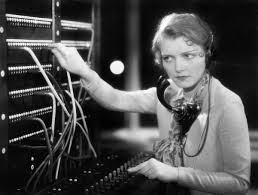Why an Undertaker Reinvented How Telephones Work

When you place a telephone call, magic happens. You hit some buttons, the phone makes some noises, and then the machines take over. Somehow, even without another person doing anything, the phone rings on the other end. It wasn’t always that way, of course — there are plenty examples of manual telephone operators, putting random plugs connected to various cords into different ports, asking callers how they can connect their calls. The current, “magic” version required an invention, and that invention required an inventor. That inventor was Almon Strowger, and like any inventor, he needed inspiration. That inspiration came in the form of dead bodies that he didn’t have the pleasure of working with.
In the late 1800s — around 1878, according to the 99 Percent Invisible podcast — Strowger was living in the Kansas City area, working as an undertaker. Business started to slow down, and one day, Strowger was reading his morning newspaper and noticed something troubling. As OPS Magazine (a telecom publication) recounted, Strowger read that a friend of his had passed away. Not only was Strowger upset by the loss of his friend (one hopes), but he was also taken aback by the loss of business — his friend’s widow didn’t hire him to assist with the burial. There was only one other undertaker in town, and Strowger got suspicious. He believed that his friend’s widow couldn’t have possibly chosen the other undertaker intentionally and instead looked toward more nefarious reasons. His conclusion: his competition must have somehow tricked his friend’s family.
And then Strowger came up with a plausible theory as to how such a thing could happen. Kansas City, like the rest of the telephone-using world at the time, had manual switchboard operators who directed calls from person to person and, in this case, widow to undertaker. And as it turned out, the other undertaker in the area was married to the switchboard operator. Strowger suspected that the switchboard operator-wife of his competitor was diverting Strowger’s clients to her better half. So Strowger took action. But instead of simply trying to get the switchboard operator fired (which may have been difficult as he had no evidence to back up his theory), he decided to eradicate her entire profession. He set off to automate her job.
Strowger’s idea came in the form of a non-functioning prototype — he was an undertaker, not an engineer, after all — which used hairpins and a pencil to demonstrate how phone calls could be connected without the need for a human operator. Using this model, he was able to obtain a patent and then, having something of value, found the money to produce the actual technology, now called the Strowger Switch. By 1892, he had set up the world’s first direct-dial telephone system and, by 1898, sold his company (and the patent), according to the Kansas Historical Society.
Shortly thereafter, Strowger moved to Florida. But, despite having a good amount of money, he didn’t retire. He returned to work — as an undertaker.
 Bonus Fact: According to NetworkWorld, the first documented prank phone call occurred in 1884. (“Documented” is important — it’s very likely that there were many undocumented such pranks beforehand, but for good reason, those didn’t make the news.) Oddly enough, the target of that phone call? Undertakers! The report, via a publication known as “The Electrical World,” read as follows: “Some malicious wag at Providence R.I. has been playing a grave practical joke on the undertakers there, by summoning them over the telephone to bring freezers, candlesticks and coffin for persons alleged to be dead. In each case the denoument was highly farcical, and the reputed corpses are now hunting in a lively manner for that telephonist.”
Bonus Fact: According to NetworkWorld, the first documented prank phone call occurred in 1884. (“Documented” is important — it’s very likely that there were many undocumented such pranks beforehand, but for good reason, those didn’t make the news.) Oddly enough, the target of that phone call? Undertakers! The report, via a publication known as “The Electrical World,” read as follows: “Some malicious wag at Providence R.I. has been playing a grave practical joke on the undertakers there, by summoning them over the telephone to bring freezers, candlesticks and coffin for persons alleged to be dead. In each case the denoument was highly farcical, and the reputed corpses are now hunting in a lively manner for that telephonist.”
Take the Quiz!: What Country is Being Dialed?: This is a really neat quiz and a nice play on words, too. Click to see how it works.
From the Archives: Barbed Bells: How barbed wire fences ushered in the era of rural telephone use.
Related: Retro-fy your smart phone.
